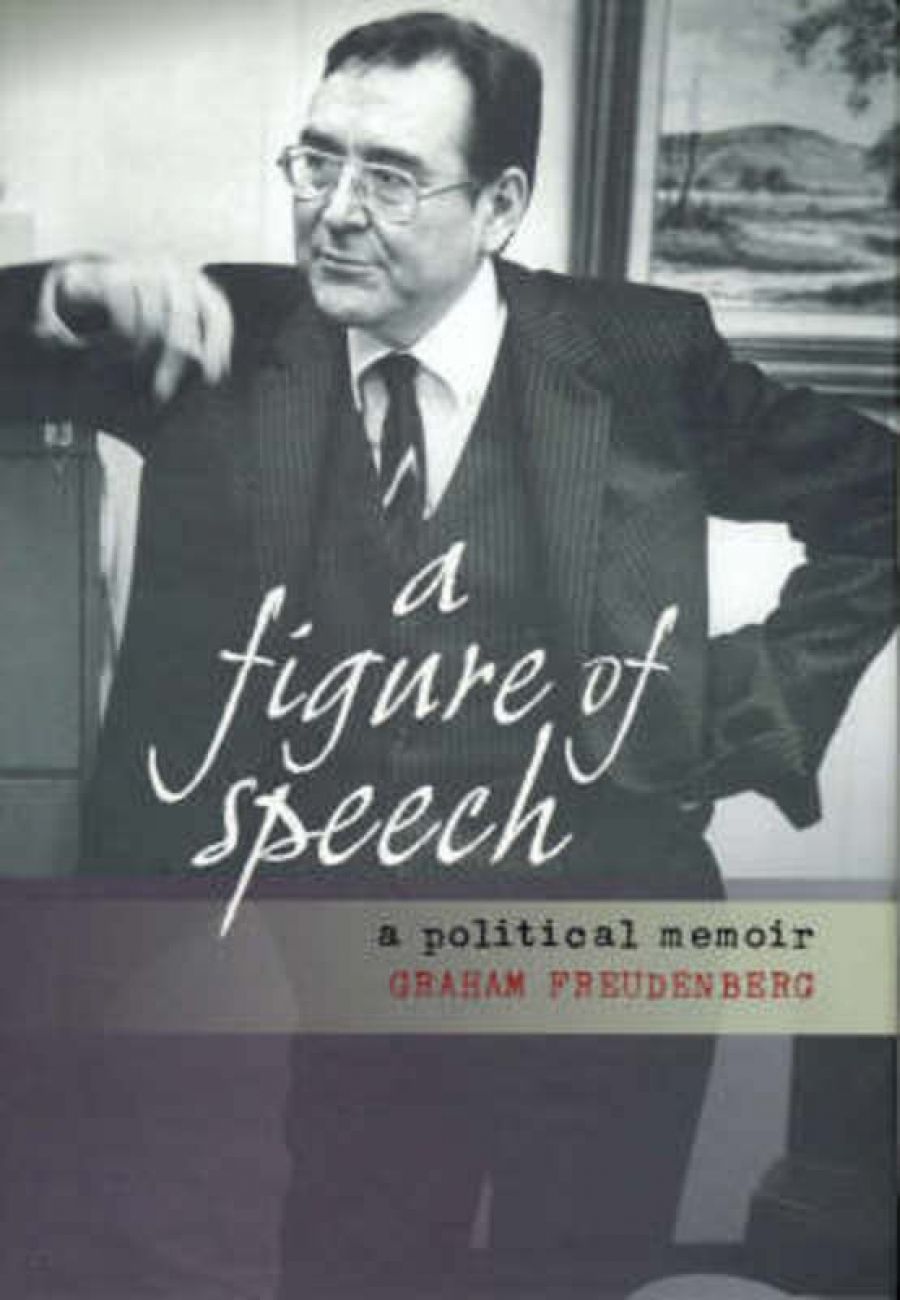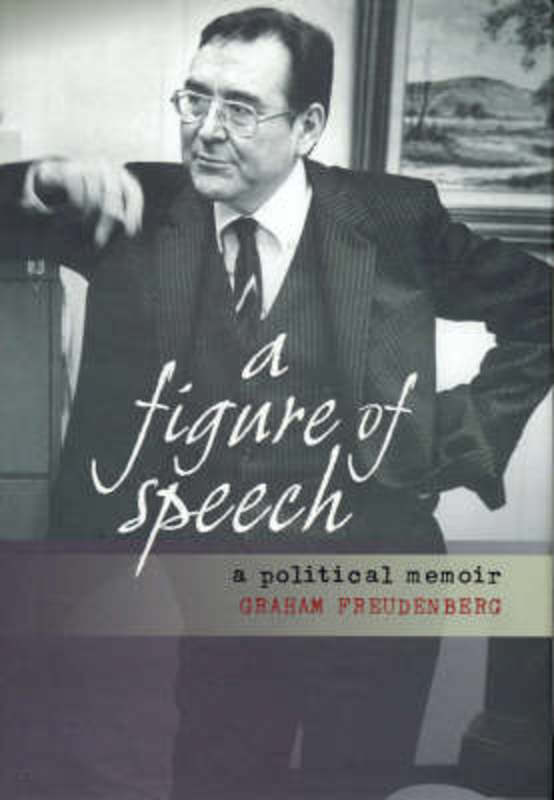
- Free Article: No
- Contents Category: Politics
- Review Article: Yes
- Article Title: Noble compromises
- Online Only: No
- Custom Highlight Text:
Graham Freudenberg, who has been at the centre of federal and NSW Labor politics for more than forty years, has now written his political memoir. Elegantly presented by his publisher, A Figure of Speech details Freudenberg’s life story, from his childhood in Brisbane to his early career in journalism, a rite of passage to London, and the vicissitudes of life in politics.
- Book 1 Title: A Figure of Speech
- Book 1 Subtitle: A political memoir
- Book 1 Biblio: Wiley, $44.95 hb, 307 pp, 1740311051
- Book 1 Cover Small (400 x 600):

- Book 1 Cover (800 x 1200):

These premiers and prime ministers have much reason to be grateful to Freudenberg, but the latter’s modesty, and his strict code that he who speaks the words possesses them, precludes excessive self-gratification, or any claims of ownership. A ‘speech once delivered’, he argues, ‘belongs to the speaker’.
Given the author’s track record, the people he has known and the events he has witnessed, A Figure of Speech comes with high expectations. There was a sense that, having enjoyed such close relationships over many years with the men who have led their party through triumphs and defeats, Freudenberg would have much to reveal. What insights would he offer on events long past? And what about gossip? Would he turn on his party or its leaders, like so many other political memoirists?
Drawing on his previous works, Freudenberg offers a flowing narrative, bringing in complex events and personalities with the author’s own role, against a backdrop of social and political history since the 1960s. This is the story of Freudenberg as political journeyman: from a conservative suburban upbringing (‘I come from the same stable as John Winston Howard’) to a career in journalism and a philosophical transformation. It also offers an insider’s perspective on Labor politics from Calwell to Iemma. There is the rise and fall of political leaders, the famous election wins and the notorious defeats, moments of high drama and emotion, and the struggle to implement a reform agenda.
Freudenberg is surprisingly frank about moments when he believes he failed his masters by not offering more insightful political advice. But he only fell out significantly with one of them: Calwell. While grateful for the start that Calwell gave him, and for the opportunity to develop his role from press secretary to speechwriter, by 1964 Freudenberg realised ‘the hopelessness of his (Calwell’s) position’. When Calwell declined to support state aid and instead under-mined Whitlam, Freudenberg resigned.
A Figure of Speech prizes brevity and economy, favouring sharp and insightful analysis over long, complex, turgid policy and political analysis, or detailed critical retrospection. It contains little gossip and few significant historical insights. It does include a criticism of federal Labor’s current state, and argues for a greater recognition of the Hawke and Keating economic reforms as the basis of Australia’s recent prosperity. Freudenberg’s panacea is to embrace Labor’s past and to develop a new programme based on the ‘unifying theme’ of ‘equality’.
Discussing the landmark speeches, their context and the leader’s delivery, Freudenberg presents many speeches in full or in part. This serves to place the reader in the audience, but with the benefit of the behind-the-scenes machinations that preceded the delivery of the speeches. There are some insights into Freudenberg’s technique. Often crafted late at night, sometimes dictated, and usually fuelled by alcohol and cigarettes, they combined research, ideas, other people’s suggestions and borrowed lines. The ‘true art of the speechwriter,’ he says, ‘is to sink one’s natural style into at least a semblance of the speaker’s own style.’
At the age of ten, Freudenberg, motivated by reading Benjamin Disraeli’s parliamentary speeches, decided that he ‘would make writing and politics’ his life. Placing Abraham Lincoln on a pedestal as the manifestation of ‘oratory in its highest form’, Freudenberg drew lessons from his ‘relentless logic and closely reasoned argument by which he reached the inevitability of his noble compromises’. Further inspired by Winston Churchill, Edmund Burke and ‘the majesty of English prose’ exemplified by Macaulay and Gibbon, he has written the policy speeches for fourteen federal elections and nine NSW elections, and has contributed words for many others.
Freudenberg also offers a few thoughts on the changes to the party’s structure and internal operations. It is here that he offers a slight criticism of the party he has served so long. He laments the ‘dominance’ of the parliamentary party and the party machine over the rank-and-file members, now ‘squeezed out between the two’.
Of his personal life, Freudenberg tells us little. A delightful series of early chapters reflect on his upbringing, his parents and his schooling. There is a line or two about his marriage, which was ultimately destroyed by his dedication to work, but there is no detailed account of his non-political passions, his motivations or his loves. While he says the work required for party preselection and the demands on a politician’s life nullified his ambitions for political office in the 1950s, he did win preselection for the NSW Legislative Council in 1991. However, factional manoeuvring placed him in an unwinnable position. He has never held parliamentary office.
This is not Freudenberg’s first book. His previous works, A Certain Grandeur: Gough Whitlam in Politics (1977) and Cause for Power (1991), the official history of the NSW Branch of the Labor Party, are fine reads, and cover much of the ground in this book. Anyone interested in Australia’s modern political history, Labor’s contribution, and the role of Freudenberg’s sextet of leaders, will find this book rewarding.
It is tempting to compare this work to Don Watson’s opus on Keating (Recollections of a Bleeding Heart, 2002) or Stephen Mills’s memoir of the Hawke government (The Hawke Years, 1993). Although these accounts are more passionate and perhaps more defensive, A Figure of Speech takes a longer view of political events, and provides a more reflective and historical analysis, which is equally satisfying.
With sharp analysis, wit and reflection, a flair for storytelling, and a readable style, Freudenberg holds the reader’s attention from start to finish, recording a life at the centre of Labor politics. Many of these moments in history have been covered elsewhere, but Freudenberg offers a valuable perspective on a well-documented subject.


Comments powered by CComment